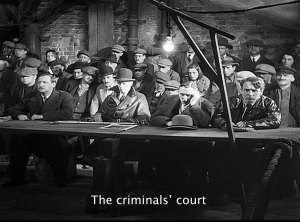Quick recap: A bunch of rich people do dumb rich people things like have affairs with their friends and needlessly kill small animals. And despite being on the brink of a war, no one mentions anything related to Hitler’s escalation.

Fun(?)fact: Although partly a myth, the film was really unpopular when it was first released. One person tried to burn down the theater it was playing in using a lit newspaper.
Thoughts and observations:
A conversation with my 11 year-old, after we had finished watching this movie-
Me: You are a trooper for sitting through two hours of subtitles and watching something made in the 30s!
B: You didn’t like it? I thought it was really funny!
Me: Maybe I just didn’t get the humor. It’s probably something complicated like every character stands for a different aspect of high society.
B: I just thought everyone was ridiculous, especially the guy who couldn’t get out of the bear suit. The one part of the movie I didn’t like was when everyone went hunting and killed all those rabbits and birds for no reason. I hated them
Me: Well, anyway, I’m going to do some research and find the true meaning of what this movie was about. French films are always way more complicated than they appear.
And then after ‘hours’ of research (I read the full Wikipedia article), I realized that my kid hit the nail on the head. This movie is about the ridiculousness of society and how they could throw parties and fall in love and get stuck in bear suits when World War II is on the cusp of beginning. And the hunting scene was put there to show how casually the rich felt about the taking of innocent life. If that wasn’t too on the nose for you, there is also a scene in which two women discuss getting the new Diphtheria vaccine. Because when you are rich, that is just a choice you can make. Good thing we’ve never had to revisit that discussion!!
As it turns out, my son would make a good reviewer one day. Then again, he hasn’t sat through the pile of French films I have and developed his own jaded attitude. One day, kid. One day.
Watchability score: 3/5 for me. If you are 11 though, apparently this is a 5/5
Up next: Man of Marble






